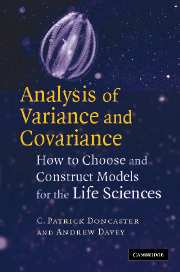Book contents
- Frontmatter
- Contents
- Preface
- Introduction to analysis of variance
- Introduction to model structures
- 1 One-factor designs
- 2 Nested designs
- 3 Fully replicated factorial designs
- 4 Randomised-block designs
- 5 Split-plot designs
- 6 Repeated-measures designs
- 7 Unreplicated designs
- Further Topics
- Choosing experimental designs
- How to request models in a statistics package
- Best practice in presentation of the design
- Troubleshooting problems during analysis
- Glossary
- References
- Index of all ANOVA models with up to three factors
- Index
- Categories of model
Choosing experimental designs
Published online by Cambridge University Press: 13 November 2009
- Frontmatter
- Contents
- Preface
- Introduction to analysis of variance
- Introduction to model structures
- 1 One-factor designs
- 2 Nested designs
- 3 Fully replicated factorial designs
- 4 Randomised-block designs
- 5 Split-plot designs
- 6 Repeated-measures designs
- 7 Unreplicated designs
- Further Topics
- Choosing experimental designs
- How to request models in a statistics package
- Best practice in presentation of the design
- Troubleshooting problems during analysis
- Glossary
- References
- Index of all ANOVA models with up to three factors
- Index
- Categories of model
Summary
Empirical research invariably requires making informed choices about the design of data collection. Although the number and identity of experimental treatments is determined by the question(s) being addressed, the investigator must decide at what spatial and temporal scales to apply them and whether to include additional fixed or random factors to extend the generality of the study. The investigator can make efficient use of resources by balancing the cost of running the experiment against the power of the experiment to detect a biologically significant effect. In practice this means either minimising the resources required to achieve a desired level of statistical power or maximising the statistical power that can be attained using the finite resources available. An optimum design can be achieved only by careful planning before data collection, particularly in the selection of an appropriate model and allocation of sampling effort at appropriate spatial and temporal scales.
Inadequate statistical power continues to plague biological research (Jennions and Moller 2003; Ioannidis 2005), despite repeated calls to incorporate it into planning (Peterman 1990; Greenwood 1993; Thomas and Juanes 1996). Yet efficient experimentation has never been more in demand.
- Type
- Chapter
- Information
- Analysis of Variance and CovarianceHow to Choose and Construct Models for the Life Sciences, pp. 248 - 257Publisher: Cambridge University PressPrint publication year: 2007



